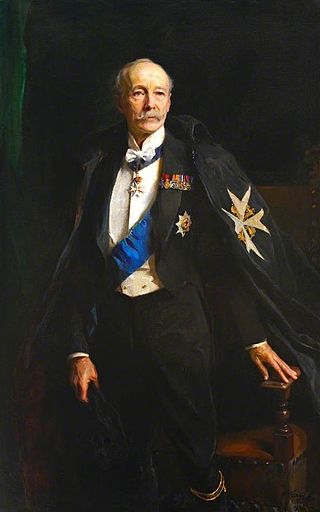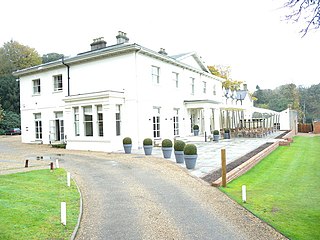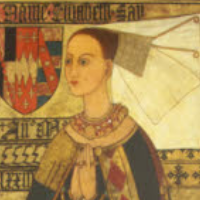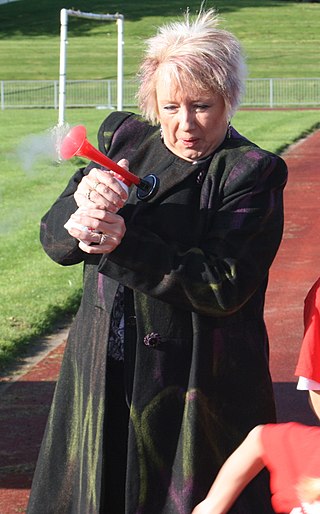
Pontefract is a historic market town in the City of Wakefield, a metropolitan district in West Yorkshire, England. It lies to the east of Wakefield and south of Castleford. Historically part of the West Riding of Yorkshire, it is one of the towns in the City of Wakefield district and had a population of 30,881 at the 2011 Census. Pontefract's motto is Post mortem patris pro filio, Latin for "After the death of the father, support the son", a reference to the town's Royalist sympathies in the English Civil War. Small villages and settlements in the immediate area include Stapleton.

Earl of Scarbrough is a title in the Peerage of England. It was created in 1690 for Richard Lumley, 2nd Viscount Lumley. He is best remembered as one of the Immortal Seven who invited William of Orange to invade England and depose his father-in-law James II. Lumley had already been created Baron Lumley, of Lumley Castle in the County of Durham, in 1681, and Viscount Lumley, of Lumley Castle in the County of Durham, in 1689. These titles are also in the Peerage of England. The title of Viscount Lumley, of Waterford, was created in the Peerage of Ireland in 1628 for his grandfather Sir Richard Lumley, who later fought as a Royalist in the Civil War.

Featherstone is a town and civil parish in the City of Wakefield, West Yorkshire, England, two miles south-west of Pontefract. Historically part of the West Riding of Yorkshire, in 2011 it had a population of 15,244. Featherstone railway station is on the Pontefract Line.

James Paine (1717–1789) was an English architect. He worked on number of country houses such as Chatsworth House, Thorndon Hall and Kedleston Hall.

Major General Aldred Frederick George Beresford Lumley, 10th Earl of Scarbrough, styled Viscount Lumley from 1868 to 1884, was an Anglo-Irish peer, soldier and landowner. He was noted for his long service in both the Territorial Army and politics, which included 60 years in the House of Lords, and for his contributions to the growth of the seaside resort of Skegness, Lincolnshire.

Kesgrave Hall is a country house located in woodlands north of the town of Kesgrave, which itself is on the eastern outskirts of Ipswich, in Suffolk, England. It was constructed in 1812 by William Cunliffe-Shawe, and has been extended since, notably by the addition of a northern extension. The building has five large rooms downstairs, with another two in the northern extension, with a further seven upstairs.
Wentbridge is a small village in the City of Wakefield district of West Yorkshire, England. It lies around 3 miles (5 km) southeast of its nearest town of size, Pontefract, close to the A1 road.
Edward Adam Leatham was an English Liberal Member of Parliament.

Elizabeth Cheney was a member of the English gentry, who was the great-grandmother of Anne Boleyn, Jane Seymour, and Catherine Howard, three of the wives of King Henry VIII of England, thus making her great-great-grandmother to King Edward VI, the son of Henry VIII and Jane Seymour, and Elizabeth I, the daughter of Henry VIII and Anne Boleyn. Her first husband was Sir Frederick Tilney, and her second husband was Sir John Say, Speaker of the House of Commons. She bore a total of eight children from both marriages.

Hambleton Hall is a hotel and restaurant located in the village of Hambleton close to Oakham, Rutland, England. The restaurant has held one star in the Michelin Guide since 1982.
Richard Lumley-Saunderson, 4th Earl of Scarbrough PC was a British peer, styled Viscount Lumley from 1740 to 1752.
Sir Edward Rodes, also called Edward Rhodes, of Great Houghton, Yorkshire, served as High Sheriff of Yorkshire and colonel of horse under Cromwell; he was also a member of Cromwell's privy council, sheriff of Perthshire, and represented Perth in the parliaments of 1656–8 and 1659–1660. Sir Edward's sister Elizabeth was third wife and widow of Thomas Wentworth, 1st Earl of Strafford.

Karen Elizabeth Lumley was a British Conservative politician and the Member of Parliament (MP) for Redditch in Worcestershire from 2010 to 2017.

Maud Alice Burke, later Lady Cunard, known as Emerald, was an American-born, London-based society hostess. She had long relationships with the novelist George Moore and the conductor Thomas Beecham, and was the muse of the former and a champion of and fund-raiser for the latter. She was a supporter of Wallis Simpson during the British abdication crisis of 1936, vainly hoping for a court appointment. The Second World War ended her era of private patronage and lavish hospitality.

Marshall Meadows House is a Georgian mansion and the most northerly hotel in England, located north of Berwick-upon-Tweed, Northumberland, in northeastern England. Currently trading as Marshall Meadows Manor House, the hotel is set in 15 acres (6.1 ha) of grounds only 275 metres (902 ft) from the border with Scotland.

Beatrice of Savoy was Marchioness of Saluzzo by marriage to Manfred III, Marquess of Saluzzo, and Queen of Sicily by marriage to Manfred, King of Sicily between 1258 and 1259. She was regent of Saluzzo during the minority of her son in 1244.

Solberge Hall near Northallerton, North Yorkshire, England, is a wedding and events venue offering exclusive use to couples. The house is a Georgian house of historical significance. It was built in 1824 by John Hutton, a local landowner. It remained in the Hutton family for about one hundred years and was then purchased by Benjamin Talbot the inventor. After an extensive multi-million pound refurbishment and restoration programme, Solberge Hall is now a wedding and events venue set in a private estate in North Yorkshire.

Larpool Hall, Whitby in Yorkshire is a Georgian house of historical significance and is listed on the English Heritage Register. It was built in the late 1780s and was a private residence for about two centuries. It is now a hotel which provides accommodation and a sociable bar.

The Scarthwaite Country House Hotel at Crook O’Lune near Caton in Lancashire is a house of historical significance. It was built in 1858 by Adam Hodgson, a merchant, banker and abolitionist. It was then the home of several notable people over the next century before being converted to a hotel. It still serves as a hotel which provides accommodation, restaurant facilities and caters for special events.

Easby Hall near Richmond in North Yorkshire, England is a building of historical significance and is listed on the English Heritage Register. Built in 1729 by the Reverend William Smith, Easby Hall became the home of many notable people for the next two and a half centuries. It now provides bed and breakfast accommodation and is a venue for special events.





















